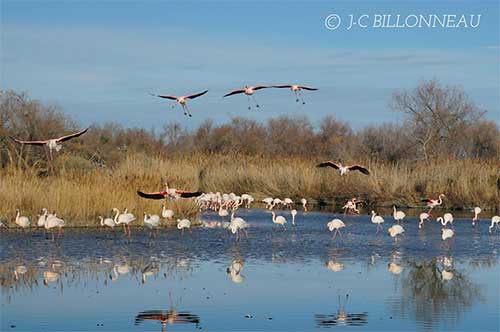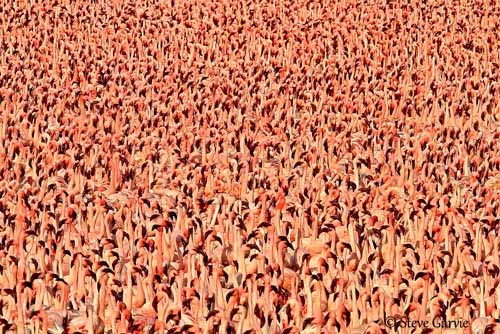
Humans have been fascinated by flamingos since long time. Let hope they protect them now and in the future, in order to allow our kids to see these beautiful birds in the wild instead in zoos, and to follow their footprints in the sand ...
Text by Nicole Bouglouan
Photographers:
Alfredo Colón
Puerto Rico Wildlife
Jean-Claude Billonneau
Photographe-témoin de la Beauté du Monde
Jean Michel Fenerole
Photos d’Oiseaux du monde
Steve Garvie
RAINBIRDER Photo galleries
Jean-Claude Jamoulle
A la rencontre des Oiseaux
Eduardo Andrés Jordan
MIS AVES – AVES DE ARGENTINA
Tom Merigan
Tom Merigan’s Photo Galleries
Jean Marc Rabby
Des Ailes et des Plumes
Philippe and Aline Wolfer
OISEAUX D'ARGENTINE
Nicole Bougloouan
PHOTOGRAPHIC RAMBLE
Sources:
HANDBOOK OF THE BIRDS OF THE WORLD vol 1 by Josep del Hoyo-Andrew Elliot-Jordi Sargatal - Lynx Edicions - ISBN: 8487334105
THE HANDBOOK OF BIRD IDENTIFICATION FOR EUROPE AND THE WESTERN PALEARCTIC by Mark Beaman, Steve Madge - C. Helm - ISBN: 0713639601
L’ENCYCLOPEDIE MONDIALE DES OISEAUX - Dr Christopher M. Perrins - BORDAS - ISBN: 2040185607
BirdLife International (BirdLife International)
CREAGUS@Monterey Bay (Don Roberson)
ANIMALS – Explore, discover, connect
Wikipedia, the free encyclopaedia
FAMILY PHOENICOPTERIDAE
Flamingos
This family includes six species and three genera. These large waterbirds, with their long legs, long neck, pink plumage and this stunning downcurved bill, are quite unmistakable.
Flamingos are graceful birds, very agile in their movements in spite of their tall silhouette and large size.
The breeding season involves spectacular collective displays during which flamingos move together like a pink cloud walking and waving over the water. Flocks of several hundreds and even thousands are common. They gather at large saline or alkaline lakes, and can be seen from sea-level up to 5000 metres of elevation.
The flamingo was considered the incarnation of the legendary Phoenix at the beginning of the Christian area. This bird was mentioned in legends, and myths derived from it. However, flamingos suffered direct and intense persecutions for various purposes. They are now protected by laws and their populations appear stables, but the Andean species need more information.

The three genera, Phoenicopterus, Phoeniconaias and Phoenicoparrus show very slight differences, but the six species can be separated by the bill structure. The genus Phoenicopterus has relatively primitive feeding apparatus, whereas Phoeniconaias and Phoenicoparrus have more specialized bill.
This remarkable tool allows the flamingos to filter water and mud, in order to retain only the food. Both edges and inner parts of mandibles are covered in corneous lamellae set in rows, themselves covered in fine moving hairs. The tongue also plays an important role in feeding behaviour by moving back and forwards. It is used like a piston in a pump, pushing mud and water towards the lamellae to filter them, and finally to retain the preys.
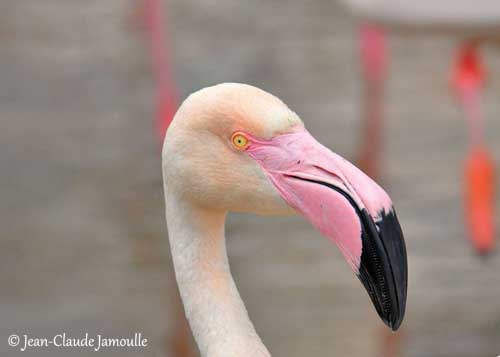
When feeding in lakes, the flamingo walks slowly with the head and most of the neck underwater. The bill is held horizontally and pointing backwards. The mandibles are partially open and the lamellae are depressed. Mud and water cross the bill and then, these lamellae are raised to trap the particles. Finally, the food is guided to the throat by the spines which cover both tongue and palate.

But the highly specialized Lesser Flamingo feeds near surface in calm water, and with the bill partly submerged, by walking and swimming. This specie has different bill, with outer lamellae that filter the larger items and inner ones much closer together than in Greater Flamingo. So, both species take different preys.

In the same way, the Puna Flamingo has shortest bill of any flamingos, with very restricted filtering area. It feeds mainly on diatoms (Bacyllariophyceae).
Thanks to their different bills (internal shape and arrangement of lamellae and hairs), if two species are feeding in the same habitat, they do not feed on the same preys and avoid competition.
The plumage colour of the flamingos depends directly on their food such as algae, invertebrates, crustaceans and various abundant micro-organisms which synthetize carotenoid pigments ingested by the bird. Then, the hepatic enzymes of the bird are able to break down the carotenoids which are converted into pigments. These pigments are found in feathers, bare skin and egg yolks.
According to the species, the bill show several colours.
The Greater Flamingo (Phoenicopterus roseus) has pink bill with black tip. This is an Old World species, living in S Spain and S France, E to Kazakhstan, S to N, W and E Africa to S Africa, and through Middle East to India and Sri Lanka.
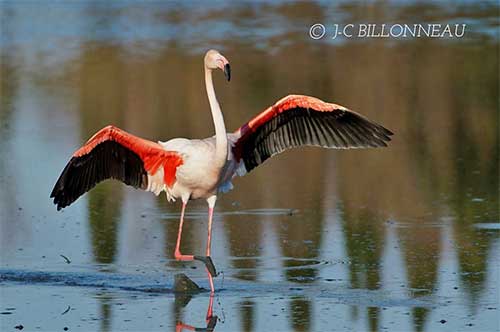
The American Flamingo (Phoenicopterus ruber) has white bill base, coral centre and black tip. It occurs in Caribbean’s and Galapagos Islands (subspecies P.r. glyphorhynchus).
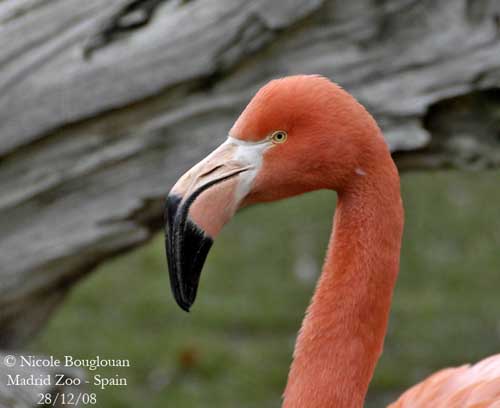
The Chilean Flamingo (Phoenicopterus chilensis) has pinkish-white base and black tip. It is found in C Peru S through Andes to Tierra del Fuego, and extends E to S Brazil and Uruguay.
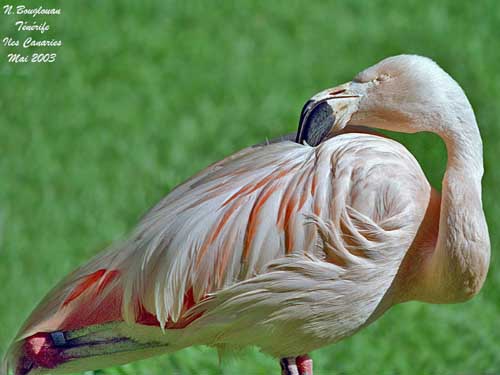
The Lesser Flamingo (Phoeniconaias minor) has deep dark red bill and black tip, but it may appears almost black. The main population is found in the Rift valley of E Africa. Three other populations occur in Namibia/Botswana, Mauritania/Senegal and NW India/Pakistan.
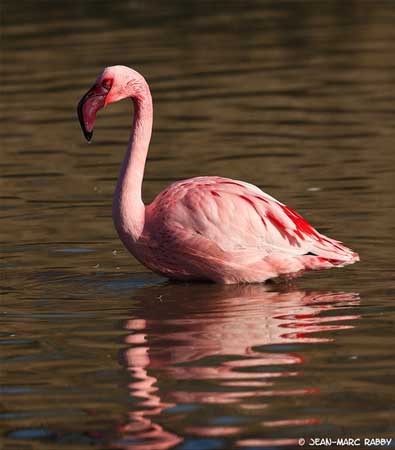
The Andean Flamingo (Phoenicoparrus andinus) has yellow bill and black tip. This species is restricted to high Andes, from S Peru through Bolivia to N Chile and NW Argentina.
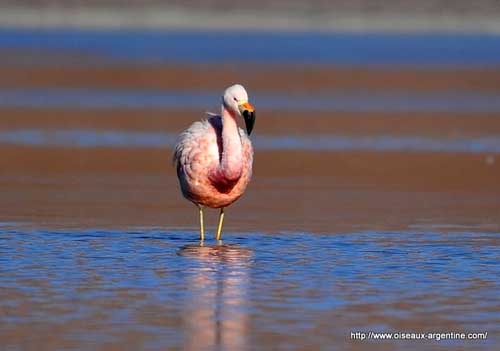
The Puna Flamingo (Phoenicoparrus jamesi) has bright orange-yellow bill with narrow black tip. This one is also restricted to limited zone in the Andes, including extreme S Peru, W Bolivia, N Chile and NW Argentina.
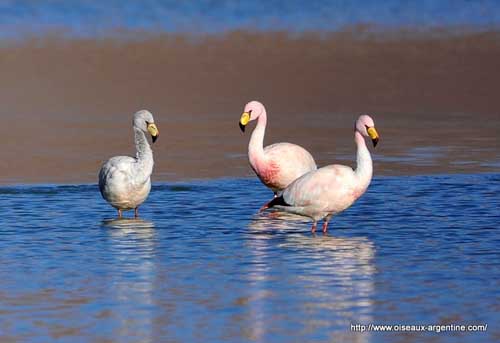
All have long legs and webbed feet, long neck, oval body and relatively small head. Their pink plumage, from very pale in Greater Flamingo, to coral-red in American Flamingo, always shows coral-red feathers or tinge on wings and/or neck base or breast. All have black flight feathers well visible in flight. The Andean Flamingo is the only one in having yellow legs and feet and the Chilean Flamingo has pale pink legs with dark pink joints. The eye is yellow in Phoenicopterus, whereas it is brown to reddish in Phoenicoparrus and Phoeniconaias.
At hatching, the chicks are covered in grey down and have straight bill and dark eyes. Later, the juveniles have grey-brown plumage with pink markings on the underparts.
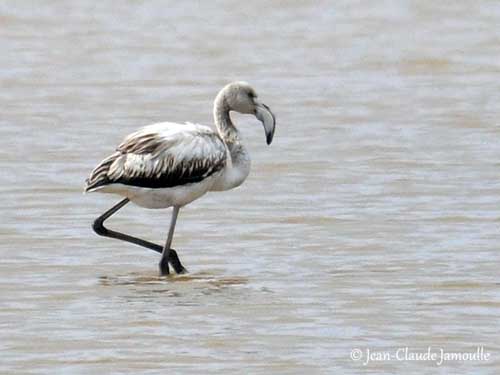

Flamingos are waterbirds, living in wet habitats, from sea-level up to high elevation in the Andes. They can be found in large, shallow saline or alkaline lakes and lagoons, sometimes with more than twice the sea water’s salinity. They frequent both coastal or inland lakes, and waters connected to the sea where flamingos are more abundant.
These caustic waters do not affect the flamingos, and constitute an extremely rich food source where they can find algae, diatoms and various aquatic invertebrates living in these waters.
However, they need to bathe and preen, preferably in fresh water, in order to remove the salt from their plumage.
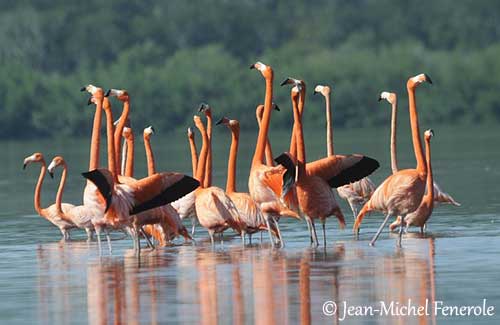
These birds are almost the only species which can survive in such harsh conditions as well with very hot waters up to 68°C or more, as at high elevation where winters are harsh with night temperatures dropping to -30°c in the altiplano. Due to volcanic origins, these waters never freeze and the flamingos can find food all winter, whereas other parts of the lake are frozen.
This bird is one of the most ancient bird’s family, and the use of very specialized habitat help them to survive, with in addition, little competition from other species.
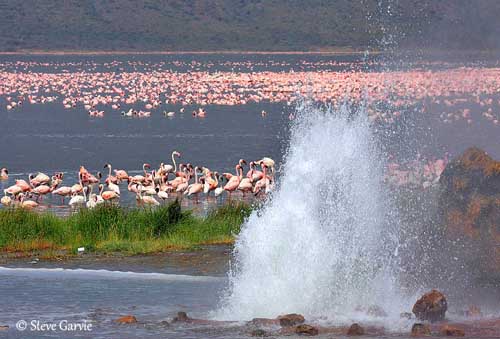
However, the Greater Flamingo is usually found at sea-level, but it can breed at high elevation, up to 3100 metres in Afghanistan. The three South American species breed between 3500 and 4500 metres, although the Chilean Flamingo can be also found at sea-level.
All flamingos breed near water, on extensive mudflats, islets or islands in salt-lakes or along the shores, rocky islands and even sandy islands of intertidal area.
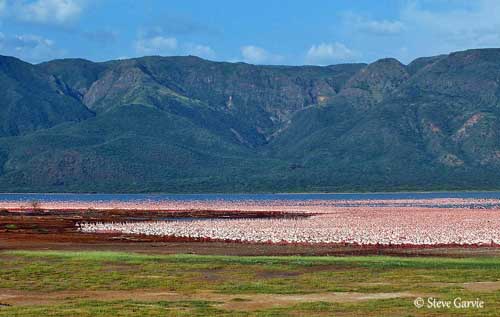
Flamingos are usually quite noisy, especially when in flocks in which the voice is used for keeping them together, but the sounds vary according to the activity. A feeding flock produces a low gabbling, while the birds in flight give nasal honking. At the colony, deep grunting, growling and loud calls are produced during displays or aggressive encounters. The ritualized displays are accompanied by calls and other sounds.
The voice is used both by parents and chicks for mutual recognition when the chicks gather at large crèche. They are very vocal from the start.
Some sounds by XENO-CANTO:
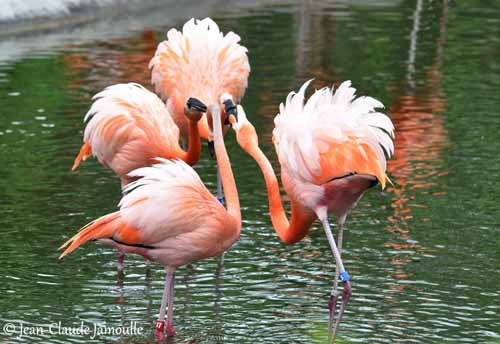
Several months before and during the breeding season, the flamingos spend considerable time in collective displays. Numerous birds, usually several hundreds or thousands according to the species, display together. They perform series of ritualized postures and movements.
The “head-flagging” shows the birds stretching the neck and raising the head with the bill pointing skywards. Then, they turn the head from side to side to the other.

The “wing-salute” consists of spreading the wings for a few seconds, in order to display the bright and contrasted colours. The tail is cocked and the neck outstretched.
The “twist-preen” during which the bird twists its neck back as for preening, with the bill behind the semi-open wing.
The “wing-leg stretch” shows the flamingo extending backwards the leg and the wing on one side of the body.
The “marching” is the most spectacular. The tightly packed and synchronized flock is walking in one direction before turning tail abruptly.
As the breeding season approaches, these displays are more often performed to increase the breeding attempts of the birds at the best periods, when water levels and food resources are good for nesting, and mainly in tropical and subtropical areas.
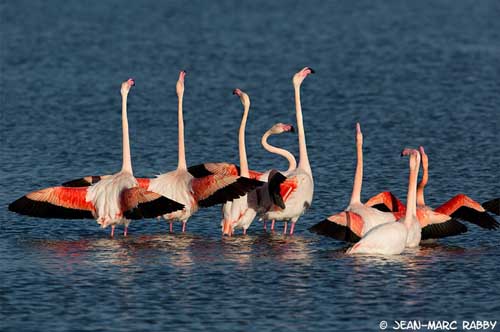
The flamingos seem to be monogamous with long-term pair-bond. The displays are less spectacular in a single pair than in flock. Copulation occurs once the pair has left the flock, with inconspicuous pre-copulatory ritual. These actions may occur at other sites, outside their eventual breeding grounds.
The flamingos breed in colony, sometimes huge ones like those of the Lesser Flamingo with several hundreds or thousands pairs, or the Greater Flamingo with several hundreds.
Other species such as the Puna Flamingo and the Andean Flamingo, form large colonies too, often mixed with Chilean Flamingo. The American Flamingo’s subspecies P.r. glyphorhynchus which breeds in Galapagos Islands, forms small colonies of about 3-50 pairs. But the nominate race American Flamingo breeds in large colonies, along lagoons and salt lakes in Caribbean’s islands.
They usually breed in spring in temperate zones, or at the beginning of the rainy season in the Andean altiplano. They breed at any time of the year in tropical and subtropical areas, and between February and December in Galapagos.
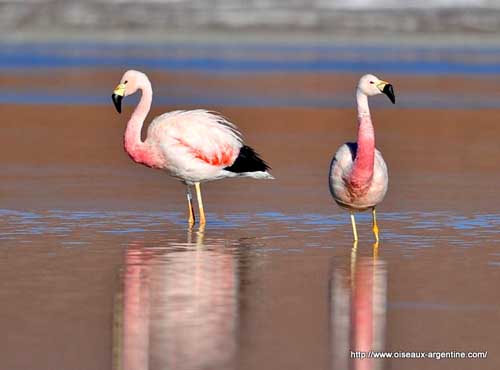
The nest is a truncated cone with a shallow depression at top. This nest is made by both adults with soft mud. If stones and plant debris are available, the birds add them to the mud. The nest-building is usually initiated by the male, and then the female follows it but more actively.
Once the egg has been laid, the building continues, often rapidly, to heighten the nest. Such nests can be reused after repair and heightening.
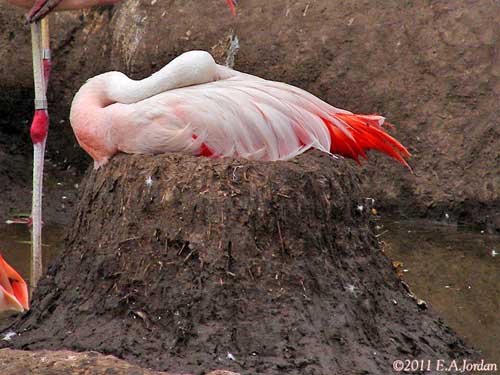
On rocky islands where soft mud is not available, the birds build only a circular rim of debris or small stones. This type of nest is found in sites where there is no danger of flooding.
There are high densities of nests in colonies. The greatest density is found in Lesser Flamingo’s colonies, with up to five nests per square meter.
The female lays only one chalky white egg. If the egg is destroyed, a replacement second egg may be laid if the loss occurs a few days after the first laying. Both sexes share the incubation, with stints of one hour to 24 hours, depending on the distance to the feeding areas. The changes are rapid and without any ceremony. Incubation lasts about 27 to 31 days in all species.
At hatching, the chick is covered in grey down and has straight bill. At four weeks old, the down is replaced by another darker downy plumage. It is brooded during 5-12 days between wing and body by an adult, and its head is often out to look around. It is able to walk and swim when it leaves the nest and joins up with numerous other chicks, forming huge crèches of hundreds or thousands of chicks. A few adults look after them.

Parents and chick recognize each other by their voices. The chick is fed by a kind of “milk”, a secretion from the adults’ upper tract. One parent holds its bill over the chick, dripping this milk into the bill of the small bird.
The young bird is able to feed itself at four/six weeks old, but its parents feed it until it fledges, about 10-12 weeks after hatching, when the bill of the juvenile has the typical bent, allowing it to filter the food. It will need several years to gain the full adult plumage.
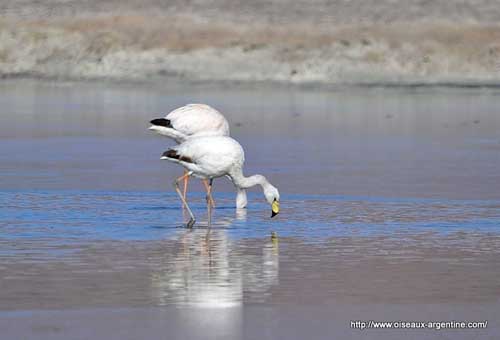
Breeding success is variable. Eggs can be lost due to predation by raptors, crows and gulls. In East Africa, the Marabou (Leptoptilos crumeniferus) destroys numerous flamingos, adults and juveniles. Some mammals, dogs and foxes, wild boars, may cause degradation and loss of eggs and chicks. But flamingos are able to maintain their populations. They can live 20-30 years and even over 50 years.
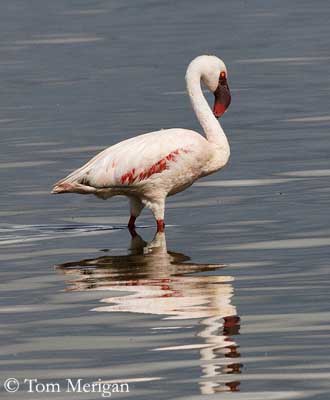
The flamingos are graceful and agile in flight. They need to run while flapping their wings to take-off if the wind is not sufficiently strong. They fly with outstretched neck. The flight is swift and direct, and the birds can reach a speed of 50-60 km/h. They perform rapid wingbeats sometimes interspersed with short glides. Before landing, the glide is longer and the bird runs a few paces when touching the ground.
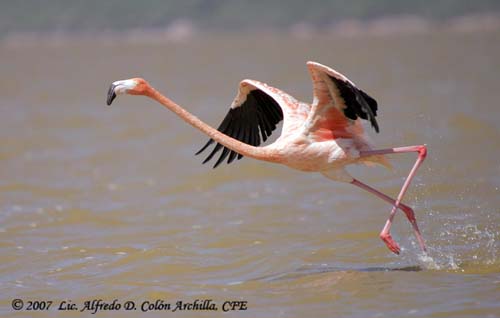
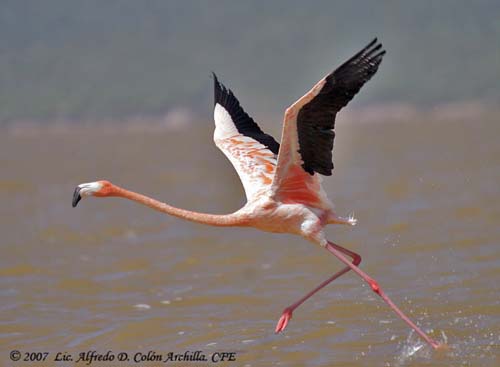
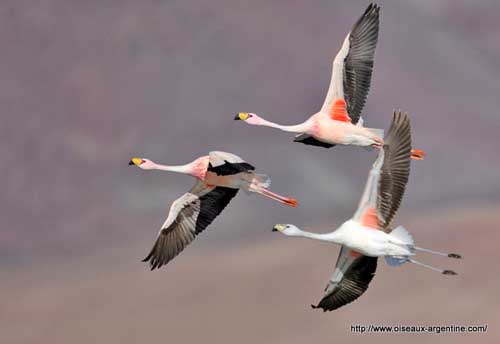
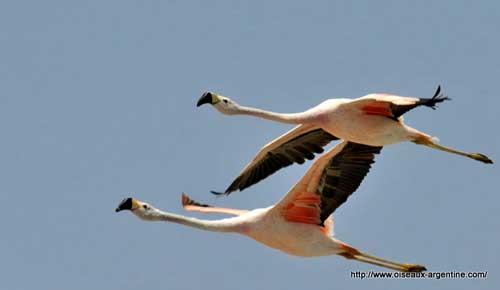
Flamingo’s flocks fly in lines or in V-formations. They disperse widely but they are not true migrants. There are altitudinal movements in populations which live at high elevation, and reach warmer areas in winter, but this is irregular or erratic. These movements depend on weather conditions. They also move when the food resources are reduced in exploited zone.
They usually migrate by night.
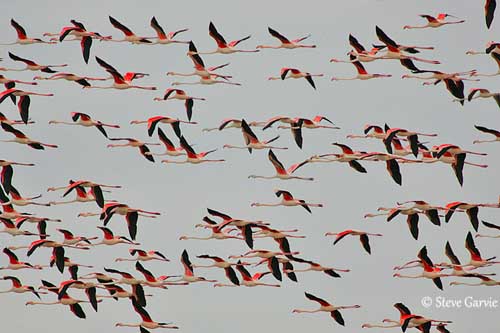
Many flamingos’ populations are affected by capture for zoos and private collections, with mortality caused by both capture and transit of the birds. Low-water levels may affect the breeding success with the decrease of the food resources. Egg and flightless young-collecting by local people for food affects the three South American species. Human disturbances and tourists at breeding colonies may also affect the reproduction.
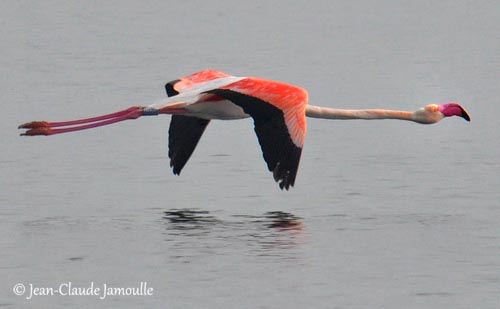
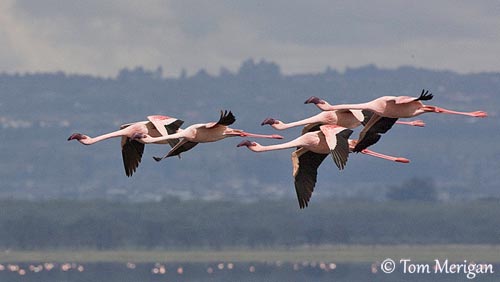
The Andean Flamingo is evaluated as Vulnerable, and the Puna Flamingo is considered as Near Threatened. The Chilean Flamingo is also evaluated as Near Threatened.
Large raptors and mammals are the main predators of the Lesser Flamingo in Africa. It is considered as Near Threatened.
The American Flamingo is threatened by habitat loss and human disturbance along the coastal wetlands of Caribbean. But the species is evaluated as Least Concern, like the Greater Flamingo.

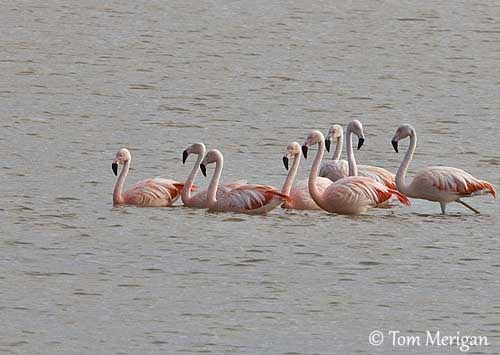
Declines are regularly reported in all populations, but these birds are able to maintain their numbers. However, their protection by laws and their presence in nature reserves help these amazing birds to survive and to breed. On several occasions, man has come to the rescue of flamingos through successful conservation efforts, construction of artificial islands if erosion was a problem, pumping in of fresh water from the areas with too much soda concentration and transfer of chicks to areas with higher water levels.
